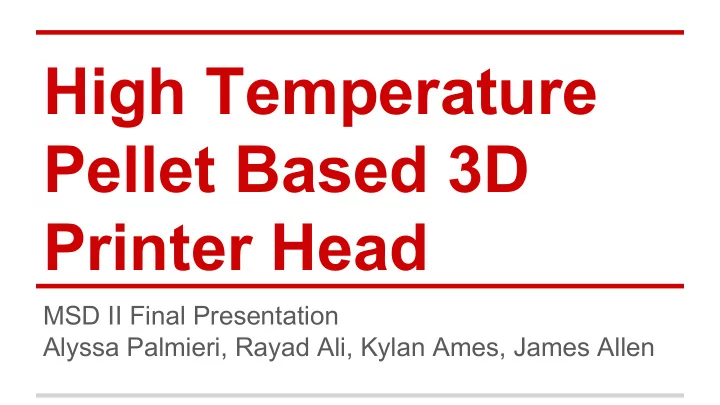

High Temperature Pellet Based 3D Printer Head MSD II Final Presentation Alyssa Palmieri, Rayad Ali, Kylan Ames, James Allen
Our Challenge The goals of this project were to design, prototype, and demonstrate a new 3D printer head that can use ordinary plastic injection molding pellets as the feedstock. It should withstand up to 380°C, is reliable and functioning for 10 hours without failure, and has interchangeable extrusion nozzles that are of roughly 75 mm cube and 1 kg mass, with different diameter holes. This print head needs to be able to work with standard hobby grade 3D printer control electronics. http://www.instructables. http://advanceplastics. com/files/orig/FX8/2Z9H/HGH6QAFH/FX82Z9HHGH6QAFH.jpg ca/product_images/uploaded_images/colored-pellets-used-for- plastic-injection-molding.jpg
Highest Importance Eng. Req.
Lowest Importance Eng. Req.
We Did The Following ● Designed and fabricated a 3D printer head ● Tested smaller stepper motors and realized we needed a motor with higher torque capabilities ● Tested pellet driving with a stock auger screw and noticed the pellets transferred to fast down the screw so we opted for an extruder screw from and a plastic extrusion manufacturer called Filabot ● Tested a heater cartridge with 250W and found that this would work for our application ● Tested pellet transportation through the metal hopper with tubing and found that it worked by itself, but not with it being attached to the pellet entry pipe ● Tested the high torque motor with the pulley system and found that the extruder screw was able to rotate within the printer head ● Tested our whole system with a 125W heater cartridge with polystyrene and the driving screw jammed ● Then we successfully tested with ABS plastic with the 125W heater cartridge, our 250W one malfunctioned before whole system testing could occur
Our Results We were able to print with ABS plastic! With .4 mm nozzle Without nozzle
Our Results
Performance vs. Requirements
Project Plan Comparison Original Plan Actual Results 1. Machining actually occurred up until the end of April 1. Machining would be done by beginning of a. designs changed based on building and February better ideas for assembly and machining from 2. Assembly would be done by end of February the shop experts 3. 2 months for testing were planned for and to 2. Assembly occurred up until the end of April be completed before Imagine a. due to machining taking so long 4. Ordering materials completed by week 6 of 3. Tested for only a month and completed in May after spring semester Imagine a. designing changes b. motor changing c. machining length d. assembly length e. issues with arduino and motor shield 4. Materials were ordered up until beginning of May (week 15) a. due to issues during testing - heater cartridge beaking, motor shield not strong enough, etc.
Final State
What We Learned 1. The opening that attaches the pellet entry pipe to the printer head gets very hot and melts the lower temperature melting pellets before they enter the driving screw 2. Set screws should be set at 90 degrees to reduce slippage of what is being set 3. Communication is everything! 4. The project plan was followed closely in the beginning of MSD II, but wasn’ t able to be followed closer to the end date 5. Heating cartridges are fragile 6. Bearings have oil that smokes at high temperature 7. Designing and machining took a lot longer than we thought 8. Order materials ahead of time and in bulk to prevent running out of them
If we had more time... 1. Design around the extrusion screw 2. Improve heat transfer to heat printer head quicker 3. Explore using a high temperature bearing 4. Redesign how pellets are entered into the system a. cool the area so the pellets don’t melt before they enter b. allow for pellets to enter consistently c. consider entering vertically 5. Use arduino for interfacing motor and temperature control to the printer head 6. Make the test rig wider and taller so the printer head is easier to access with tools 7. Ordered a higher wattage heater cartridge to get to the temperatures needed and test with ULTEM 8. Figured out a way to purge the material so the pieces within the printer head don’t get stuck 9. Standardize hardware for minimal tool changes 10. Experiment with different nozzle sizes
Thank You! Any questions?????
Recommend
More recommend